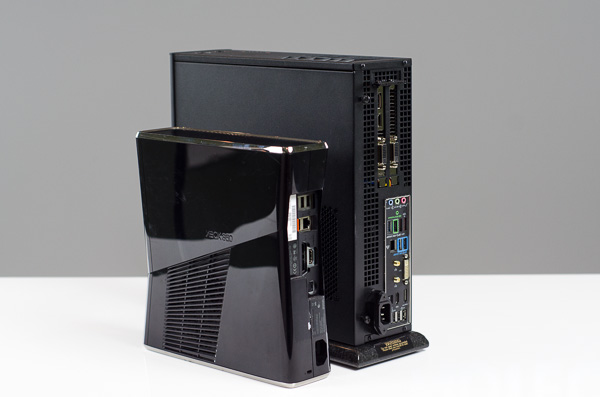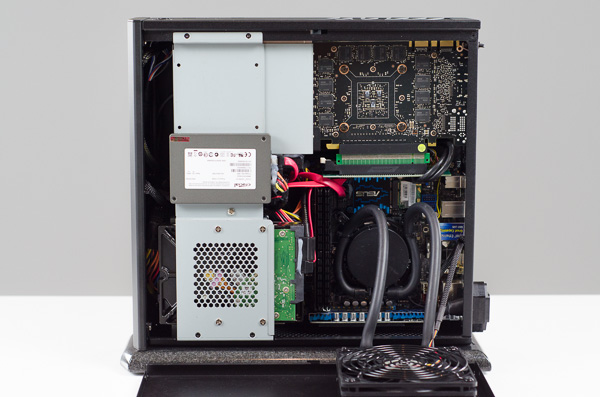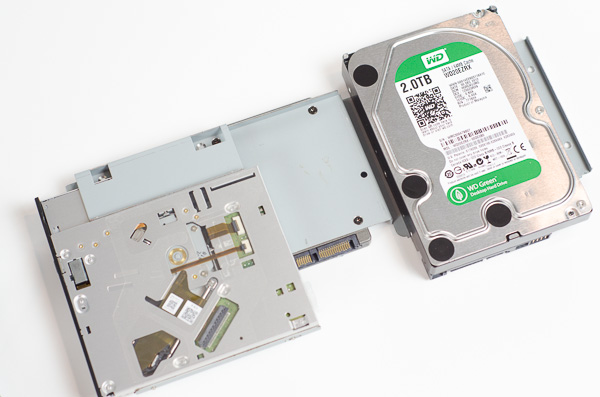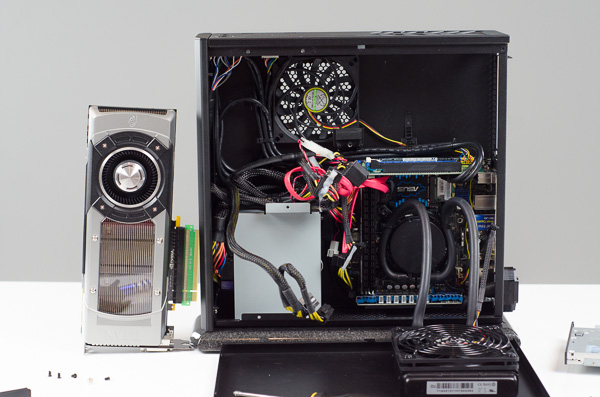High-End Meets Small Form Factor: GeForce Titan in Falcon Northwest's Tiki
by Anand Lal Shimpi on February 19, 2013 9:00 AM ESTInside the Tiki
The Tiki tower is quite compact, measuring just 4" wide. It's bigger than a new Xbox 360, but not by a huge margin. Once you consider how much more powerful this Titan equipped Tiki is, the 360 comparison becomes downright ridiculous.

Falcon NW Tiki (left) vs. Xbox 360 slim (right)
To keep the Tiki planted and from falling over, Falcon mounts it on a granite base. My review sample had a speckled black base, which seemed to be the more subtle of the available options. I appreciated the functionality of the base and the fact that my PC was sitting on a slab of granite sort of faded away. It's difficult to describe the visual impact of the Tiki chassis. Tiki's industrial design doesn't break new ground, but its aesthetic does scream sleek gaming PC. I like it. It's well executed.

Xbox 360 slim (left) vs. Falcon NW Tiki (right)
There are two USB 3.0 ports at the top of the chassis, along with a pair of audio jacks for your mic and headset. The slot loading DVD drive is also accessible from the top of the chassis. Around back you're quickly reminded that this is definitely a high-end gaming PC. There are the twin DL-DVI ports, HDMI and DisplayPort outputs driven by the GeForce Titan, as well as two eSATA ports, four USB 3.0 ports, four USB 2.0 ports, GigE, and all of the display outputs driven by the processor graphics. The ASUS board also integrates WiFi, which you can connect an external antenna to. Your standard set of analog and optical audio jacks round out the coverage. All of the labels on the IO panel are upside down so that you can lean over the top of the chassis and they appear right side up when you're plugging things in back there. It's a nice touch.
There's a healthy amount of ventilation built into the chassis. I kept a close eye on temperatures during my testing and never felt worried that I was cooking anything inside (CPU temperatures seemed to hover around 53C during heavy gaming workloads).
Despite its small form factor, the Tiki tower is remarkably simple to get inside and work on. Two thumbscrews hold the service cover in place. There's an Asetek closed loop liquid cooler mounted on the CPU, with its radiator fan mounted on the service cover so you have to be careful when opening up the machine. There's enough slack in the cooling tubes for you to lay the cover down and work on the inside of the Tiki without removing the CPU cooler.
While the Tiki normally comes with a Core i5-3470, Kelt tossed in a Core i7-3770K overclocked to 4.6GHz in my review system. Falcon will perform a factory overclock on your system for free, although there's no guarantee of what speed you'll end up with.
A total of five screws hold the drive assembly in place. There's room for two 2.5" SSDs, a 3.5" HDD and a slim optical drive in the Tiki. My review sample was outfitted pretty much the way I'd build it, with a 256GB SSD and a 2TB WD Green hard drive for data storage (ok, admittedly I'd probably toss in a 512GB SSD). Falcon offers a Blu-ray drive, but my review unit had a DVD-RW instead. I don't remember the last time I used a CD or DVD to be honest. All of the power and SATA cables are glued in place (likely to ensure safe transport), although you can easily remove them if you need to.
Today the Tiki ships with a Crucial m4 SSD by default, although Kelt is eagerly awaiting the arrival of the M500. I'm glad to see that Falcon isn't using a bad drive in the Tiki, and that the system comes with an SSD by default.
You do have to remove the drive assembly to gain access to the Titan card. A single retention screw and two bracket screws hold the GeForce Titan in place. Removing those will let you pull the card out should you need to replace it (or take photos of it).
I didn't go all the way and pull out the ASUS P8Z77-I Deluxe motherboard, but you can see how the board is surprisingly accessible once you've pulled the drive assembly out of the chassis. Other than the motherboard, only the SilverStone 450W SFX power supply would need some effort to remove.
The Tiki struck me as a good combination of a compact infrastructure that remained relatively serviceable.




















33 Comments
View All Comments
Aikouka - Tuesday, February 19, 2013 - link
I wanted to add one thing to your comparison between the Tiki and the 360 that I think makes it even more interesting: the power supply. It's pretty easy to forget given we don't necessarily consider it, but if they stuffed the power supply into the 360, it would probably come even closer to the size of the Tiki.As for Steam's Big Picture Mode (BPM), what I would love to see is better thought to the user experience. I use BPM on my Gaming HTPC along with Windows Media Center (for the superior CableCard-based tuner support). Well, the problem is that there isn't an easy way to cycle between the two pieces of software. The biggest problem is that when you exit BPM, it doesn't actually exit Steam, which can be a good thing since logging into Steam takes an absurdly long time. However, that means that you can't use a piece of software to track when Steam closes and have it reopen WMC. There's a piece of software like that which allows for switching to XBMC from within WMC.
lmcd - Tuesday, February 19, 2013 - link
Or Big Picture could just load in video plug-ins, and handle content management. Since Valve is in digital distribution I could see them teaming up with 7digital or someone to get themselves a store.cjs150 - Tuesday, February 19, 2013 - link
NVidia please produce a watercooled version! That + an i7-3770k in a Silverstone TJ08 with a 200x200mm radiator would produce a quiet, cool and super powerful system.Very impressed with how little power needed to run that system.
Only problem for me is that the GPU is way too powerful for my needs. I havent yet moved up to 1920x1080 monitor.
Falcon sure builds pretty systems
Gigaplex - Tuesday, February 19, 2013 - link
Why would NVIDIA build a watercooled version? They pretty much just build a reference platform and sell chips, it's the OEMs that do custom cooling solutions.alpha754293 - Tuesday, February 19, 2013 - link
What kind/type/speed and how much RAM is in the system that you reviewed here?mavere - Tuesday, February 19, 2013 - link
"My perspective on what's considered quiet has been sort of warped by the fact that for the past two months I've been using a 27-inch iMac as my primary system."Uhhh I get the sense that you're trying to qualify your perspective on system noise somehow, but I don't think iMacs, especially the 27" ones, are mass-market enough to be used as a general reference point.
Can you rephrase and/or link to a review? Thanks.
chizow - Tuesday, February 19, 2013 - link
Eh....don't think so. There's nothing in there that would justify that price point, it makes Alienware's X-51 seem like a steal. And the X-51 looks much nicer to boot.I do like the innovation with the daughter/riser card accomodating a full-sized GPU. Now that the cat is out of the bag on that one however, I expect more OEMs to follow suit, albeit at a much cheaper price tag. $1k + $300 for a GTX 670 would be a very attractive option, imo, and make up for the lack of grunt on the X-51's GPU options.
JonnyDough - Wednesday, February 20, 2013 - link
I'd rather have the IO Sheild/Backpanel at the top of the case, rather than the bottom for the exact reason you listed Anand. You can see it better when plugging in peripherals.The PSU and video card connections can be at the bottom. Plus, your mouse cord might be too short to accommodate your desk. You just never know.
brucek2 - Wednesday, February 20, 2013 - link
I'm surprised there were 1080p settings for Far Cry 3 that this system couldn't play. If this system can't do it... what system were they targeting?!? I guess its nice that game looks to future hardware improvements but targeting a level of hardware power that's significantly above this system seems like a very large gap.marc1000 - Wednesday, March 6, 2013 - link
it's nice to see that BOTH fans are intakes on this small chassis. they are also made by scythe. I wonder where is the PSU air output, but anyway for thermals this is a great design. the only problem would be how to block dust from entering the system.